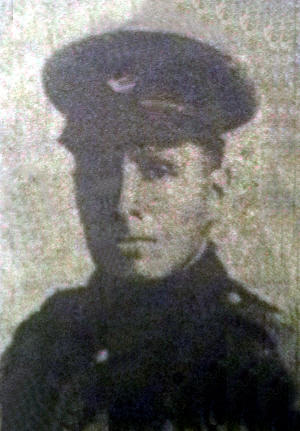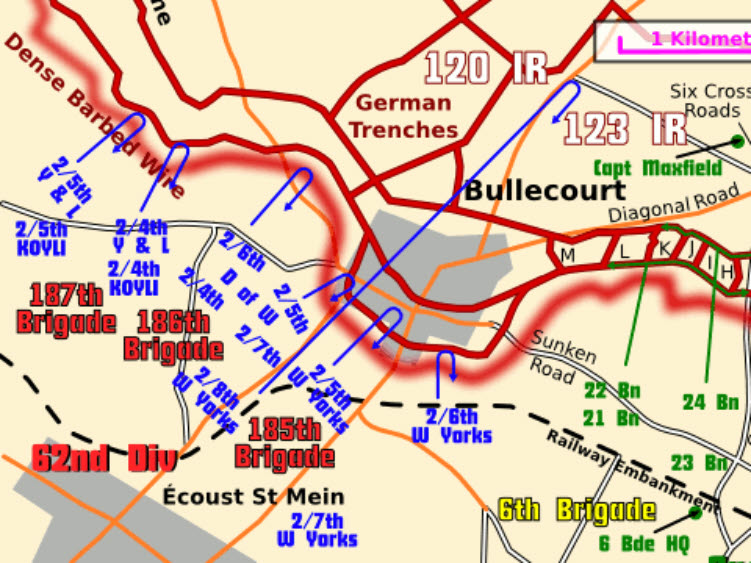
Robert Thomas Hall junior was born in Crigglestone in 1882, the elder surviving son of ten children born between 1873 and 1892 to Sandal-born Robert Thomas Hall and his wife, Hannah (nee Render), who was born in Crigglestone. The couple married in 1872 and moved from Crigglestone to Ossett in the early 1880s. Sadly, four of the children died before 1911.
In 1891, Robert Thomas Hall senior, a joiner by trade, and Hannah were living at Happy Land Row, Ossett with five of their children. By 1901, the family have moved to George Street, Healey Road, Ossett and Robert, now aged 18, was working as coal miner.
In Summer 1907 Robert Hall, aged 25, married Ossett-born Gertrude Fozzard and by early 1911 they had a son, Walter. The couple lived in Pontefract where Robert continued to work as a coal miner and they had two more children: Horace Hall born in 1912 and Gladys Hall born in 1915. All of the children were born in Pontefract.
In 1911 Robert’s parents and two sisters had moved to live on Park Square, Ossett where his father Robert worked as a cattle dealer. Robert Thomas Hall senior, of Park Square, Ossett died in 1913, aged 63.
Robert Thomas Hall’s army service record has not survived, but it is known that he enlisted at Pontefract, and that he did not serve overseas before the 31st December 1915. He was posthumously awarded the British and Victory medals.
The 2nd/5th Battalion of KOYLI was formed at Doncaster on the 10 September 1914 as a second line unit. On the 1st March 1915, the battalion moved to Bulwell and was attached to 187th Brigade in the 62nd (2nd West Riding) Division. They moved in April 1915 to Strensall, York and on in May to Beverley, going on in November to Gateshead, then in January 1916 to Larkhill and June 1916 to Flixton Park near Bungay. They moved again in October 1916 to Wellingborough. The Battalion landed at Le Havre on 15 January 1917. On the 2nd February 1918, they were absorbed into 1/5th Battalion.
The “War Diary” of the 2/5th Battalion King’s Own Yorkshire Light Infantry for the 3rd May 1917 gives details of the action in which Lance-Corporal Robert T. Hall lost his life:
2nd May 1917: Routine Y day. 8.20 pm – Left for line. Number for attack 19 Officers, 589 other ranks. 9.20 pm – Arrived ST LEGER. Hot meal served. Men in splendid spirits. 11.30 pm – Left for line. Reached forming up tape without casualties and formed up as ordered.
3rd May 1917: N.W. OF BULLECOURT. 03.37 am – Battalion moved forward at Zero LESS 8 minutes. Earlier start necessitated by moving back of tape line 300 yards from enemy line than originally planned.
3.45 am – Zero. Our artillery barrage descended at once on enemy trenches. Smoke and dust were wafted by wind on to our own troops and this combined with darkness, made direction very difficult to keep. On enemy front line being reached considerable confusion prevailed. The troops detailed for 1st objective had failed to carry this and were held up by machine gun fire. Our own officers led by LT. COL. W. WATSON who showed conspicuous bravery attempted to rally these men, and to advance in force on the trench with the object of carrying it by sheer weight of numbers. About this time nearly all officers in vicinity became casualties and attack became disorganised. Small parties reached enemy front line but failed to make much headway.
8.45 am – Second attack launched by MAJOR O.C.S WATSON with force consisting of stragglers in reaching and carrying parties succeeding in reaching enemy wire but again held up by M.G fire. Troops took up line of shells holes opposite enemy trench which they held throughout day.
8.0 pm – Order received to withdraw to original line. This was effected at dusk. MAJOR F. MELLOR assumed command of battalion. SEC LT. C.H. WEBB resumed duties of ADJUTANT.
4th May 1917: Troops remained in line taken up on previous evening.
12 noon – Ordered to withdraw to MORY COPSE
3.30 pm – Arrived MORY COPSE. Hot meal served.
5.30 pm – Order received to receive 21st MANCHESTER REGT in line.
9.0 pm – Left MORY COPSE and relieved 21st MANCHESTER REGT. Relief effected without casualties.
Casualties during operations on 3rd May: KILLED LT. COL. W. WATSON ( Somerset LI) commanding LT. E.P PATTINSON, 2 LT. B.S BREWSTER(2/6 Norfolk Regt) attached MISSING, 2 LT. F.A MOORCOCK WOUNDED, CAPT. S.S CHAPPELL, CAPT T.W MOTTRAM, CAPT. W.J OSWALD (Highland Cyclist Bn )attached LT. & ADJ A. ROBINSON, LT. C.C SNOW, LT. E.R WOODROOFE, LT. J.L SOMERS
Other ranks killed 35. Wounded 156. W.& M. 16. Missing 53. Total 260
The “Derby Telegraph”, October 2nd 1910, had this view of the second Battle of Bullecourt:
“The 62nd Division’s attack upon Bullecourt, France, on May 3, 1917, was an abysmal failure. The 2nd/5th King’s Own Yorkshire Light Infantry (KOYLI) sustained heavy casualties, with four officers killed and seven wounded. Among the ranks were 35 killed, 69 listed as missing and 156 wounded. Many of those men killed at Bullecourt but listed as missing still have no known graves. These brave men, who paid the ultimate sacrifice, still lie in the fields surrounding the battle scene.”
The “Ossett Observer” 1 had a note about Lance-Corporal Robert T. Hall being missing in action:
“Private Robert Thomas Hall, of the K.O.Y.L.I., an Ossett man is officially reported as missing. Private Hall, who is the son of the late Mr. Robert Hall, of Park-square, Ossett, is a married man with two children, and had for a few years worked at Ackton Hall Colliery, Featherstone. He joined the army two years ago, and had been in France since January. In a letter received by his brother-in-law, his platoon sergeant writes that on the 3rd May Hall took part in an attack by his battalion on an enemy position. On their return he was missing, and the sergeant says that when last seen by him he had been wounded in the foot and was taking cover in a shell-hole with some other men, and it was impossible to get any of them away. In the opinion of all his comrades, he and the men with him had been taken prisoner.”
Then, in 1918, the “Ossett Observer” 2 had this obituary for Robert Thomas Hall:
“Missing Ossett Soldier Now Reported Killed – Lance-Corporal Robert Thomas Hall (35), K.O.Y.L.I., son of the late Mr. Robert Hall, of Park-square, Ossett, who was reported as missing in June of last year, is now officially reported to have been killed. The deceased, who was a married man with two children, joined the army nearly three years ago. Just before he was missed by his unit, Hall took part in an attack by his battalion on an enemy position. On their return he was missing and a sergeant who was with him stated that when last seen by him he had been wounded in the foot and was taking cover in a shell-hole with some other men, and it was impossible to get any of them away.”

Above: 187th Brigade and 2/5th KOYLI positions on the 3rd May 1917 at the 2nd Battle of Bullecourt
Lance-Corporal Robert Thomas Hall, aged 35 years, was killed in action on the 3rd May 1917, the son of Robert Thomas and Hannah Hall, of 47, Park Square, Ossett. He is remembered on Panel Reference Bay 7 at the Arras Memorial,3 Pas de Calais, France. The Arras Memorial is in the Faubourg-d’Amiens Cemetery, which is in the Boulevard du General de Gaulle in the western part of the town of Arras. The cemetery is near the Citadel, approximately 2 kms due west of the railway station.
The French handed over Arras to Commonwealth forces in the spring of 1916 and the system of tunnels upon which the town is built were used and developed in preparation for the major offensive planned for April 1917.
The Commonwealth section of the Fauborg D’Amiens Cemetery was begun in March 1916, behind the French military cemetery established earlier. It continued to be used by field ambulances and fighting units until November 1918. The cemetery was enlarged after the Armistice when graves were brought in from the battlefields and from two smaller cemeteries in the vicinity.
The cemetery contains over 2,650 Commonwealth burials of the First World War, 10 of which are unidentified. The graves in the French military cemetery were removed after the war to other burial grounds and the land they had occupied was used for the construction of the Arras Memorial and Arras Flying Services Memorial.
The adjacent Arras Memorial commemorates almost 35,000 servicemen from the United Kingdom, South Africa and New Zealand who died in the Arras sector between the spring of 1916 and 7 August 1918, the eve of the Advance to Victory, and have no known grave. The most conspicuous events of this period were the Arras offensive of April-May 1917, and the German attack in the spring of 1918. Canadian and Australian servicemen killed in these operations are commemorated by memorials at Vimy and Villers-Bretonneux. A separate memorial remembers those killed in the Battle of Cambrai in 1917.
The adjacent Arras Flying Services Memorial commemorates almost 1,000 airmen of the Royal Naval Air Service, the Royal Flying Corps, and the Royal Air Force, either by attachment from other arms of the forces of the Commonwealth or by original enlistment, who were killed on the whole Western Front and who have no known grave.

Above: Robert Thomas Hall’s Death Plaque (aka Death Penny) & Victory Medal courtesy of Andrea Hartley who acquired and then donated these to Wakefield Museum Service. Robert was also posthumously awarded the British Medal.
References: